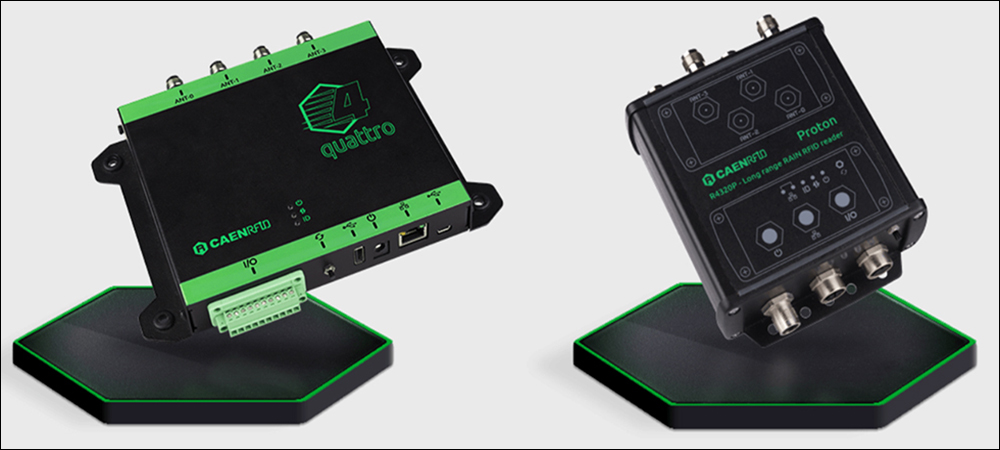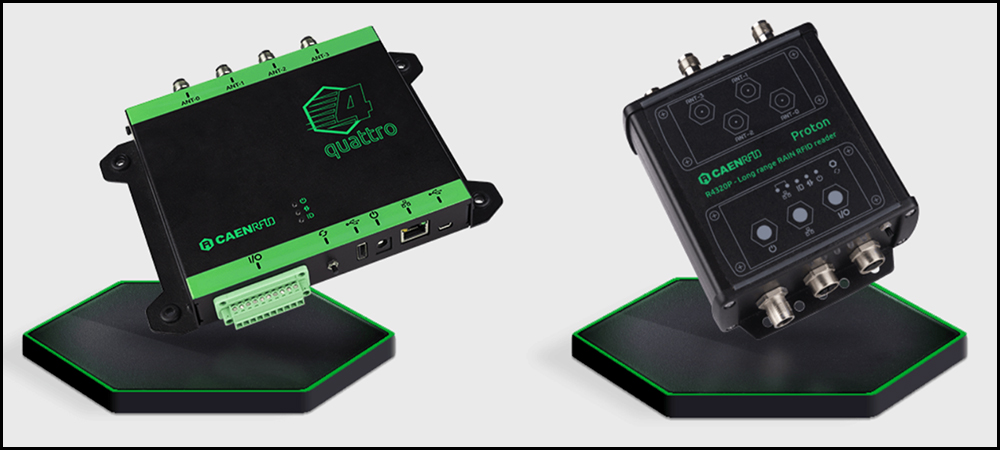Deploying and configuring fixed readers in a way that they can be integrated by an installer and controlled by end users has been among the more challenging aspects of RFID systems. Italian technology company CAEN RFID has created a solution in the form of firmware built into two of its fixed readers that is aimed at addressing this problem. The company’s Autonomous Mode is now available with its Quattro and Proton fixed readers. The mode, offered as a firmware update or built into new versions of these devices, is intended to allow installers to more easily deploy RFID technology without requiring middleware or software integration.
The solution was released in February 2022. Businesses are now sampling the new mode with modified versions of existing CAEN readers, or with new Quattro or Proton devices from CAEN RFID, and their own backend software. In recent years, the company has found that as RFID use cases expand, the complexity of integrating new readers into a user’s software system and then configuring the readers can pose an obstacle to deployment, says Stefano Coluccini, CAEN RFID’s general manager.

CAEN RFID’s Proton and Quattro readers
Therefore, the company developed a solution for use with its two most recently released readers. The Proton and Quattro models are ruggedized fixed readers that were both made available in 2020 for use in industrial settings, as portals or gates to read tags as they move through a controlled area. The Proton is a more compact device, CAEN reports, which is industrial-grade and waterproof, so the reader is also being installed on forklifts. It comes with vehicle-mounting capability and can be powered by 12- or 24-volt vehicle batteries.
Both readers come with built-in Impinj Indy chips. To set up an RFID reader, users typically need to install software to connect raw read data to an application that provides users with accessible dashboards and other information. That commonly means writing a software application using data libraries provided by the reader manufacturer, and it requires middleware that can be installed outside the reader, in the form of edge computing or on a server.
The middleware receives the information from the reader, then translates it into data that can be understood by the external software, after which the software is configured to manage that data and make it available in an intelligible format. Part of that process, Coluccini says, means IT specialists need enough skills to set up all the coding for their software. Autonomous Mode is designed to eliminate that effort, he says, adding, “Users can configure the reader using a Web interface.”

Stefano Coluccini
Systems integrators or end users can acquire and install the reader, then connect it to a power source and a server. They can employ CAEN RFID’s website to set up the configuration, which can include prompting features such as triggering tag readings based on specific conditions or events. Users could configure the power level or determine how fast the reader should interrogate tags—whether continuously or triggered by external commands, for instance.
The system also enables users to configure where and how to send the data, such as setting the reader to use a serial interface or an Ethernet connection. Installers can configure the data they receive as well. That could include the Electronic Product Code encoded on each tag, or the tag’s ID number, or full user memory. They can add a suffix and a prefix to a tag ID, allowing them to define the data format and make changes at any point. This can be accomplished in the application by selecting the “settings” tab, then clicking on one of the configuration options.
Those configurations are then saved with the reader. “After that,” Coluccini says, “it’s working with the new configuration.” As a result, systems integrators do not need to act as programmers. “They just install the reader and configure it, and the reader starts to read the tags and send data.” Autonomous Mode is targeted at customers still new to RFID, or who cannot afford the cost or labor required to configure software or middleware.
CAEN RFID offers Autonomous Mode as a firmware update for existing Proton and Quattro devices, and the company is building the firmware into the motherboards of its new products. The firm has also released several new products throughout the past year, including the Lepton 7, which is expected to be in full production later this year. That compact device is being used in handheld devices, point-of-sale readers, wearables (such as voice-operated gloves) and printers, CAEN RFID reports.
Additionally, the company recently released the skID, a mobile reader that can connect to a smartphone with a locking mechanism (see CAEN RFID Intros Portable Inventory-Management Reader). Its performance is designed to be similar to that of industrial handheld readers, CAEN notes, but with a smaller size for use with phones. It is being employed in retail, as well as in a variety of other industries, including railroads and logistics. The skID is waterproof and can be used in industrial applications as well.
Another new product, being released this month, is the trID, a UHF RFID reader that combines the attributes of a desktop reader with those of a mobile reader. The trID is a flat, tray-style device that can be placed on a shelf or countertop. While it reads tags similarly to how a desktop reader would do so, it is uniquely designed for tracking small items at close range, with mobile functionality.
The device includes a built-in battery, so it does not require a wired power source. What’s more, it contains Bluetooth and Bluetooth Low Energy (BLE) radios to transmit data to computers and devices. For instance, a jewelry store might use the trID with a customer-facing tablet. The reader would capture the unique ID number of each tagged piece of jewelry as that item was placed on it. Data about that tagged item could then be displayed on the tablet for a customer, leveraging a BLE connection.
Because the device is battery-powered, it can be placed on a counter or be brought directly to a customer within a store, without requiring an outlet for plugging it in. The tag-reading field is controlled at a short range so that a tag cannot be read more than a few centimeters from the surface. In that way, CAEN RFID explains, only items placed directly on the tray’s surface are detected by the built-in RFID antennas. Several businesses plan to deploy the trID system for other use cases, the firm reports, such as for displaying information regarding cosmetics.


